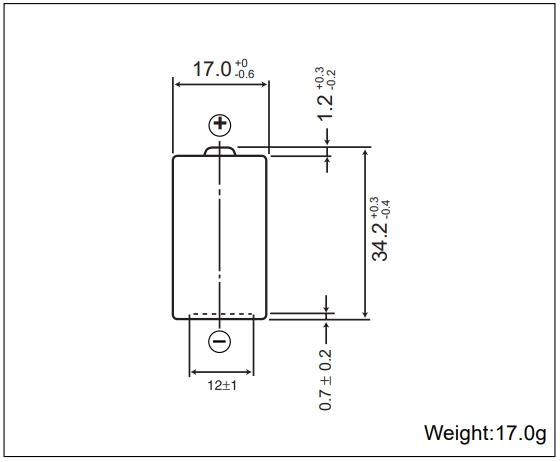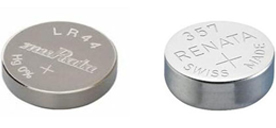CR123A vs CR123: Specifications, Differences & Equivalents
2024/12/26 15:52:13
Views:
CR123A 3v lithium battery are indispensable power sources, revered for their compact size, potent energy density, and unwavering performance across a myriad of electronic devices. This exhaustive discourse seeks to delve deeper into the nuances of CR123A batteries, elucidating their disparities from counterparts like CR123, unveiling substitute options, and illuminating their omnipresence in sectors driven by cutting-edge technology.
Which CR123A Batteries Should I Buy?
- Introduction
- Specifications of CR123A 3V Lithium Batteries
- Advantages of CR123A Batteries
- Dimensions of CR123A Batteries
- Differences Between CR123A and CR123
- Equivalents of CR123A Batteries
- Unveiling Applications and Utility of CR123A Batteries
- Fine-Tuning Battery Management and Maintenance for CR123A Batteries
- Conclusion
- Frequently Asked Questions
-
Introduction

Little, high-energy lithium batteries known as CR123A batteries are frequently found in a variety of electronic gadgets. They are known for their compact size, high voltage output, and long shelf life, making them ideal for powering devices such as flashlights, digital cameras, smoke alarms, and medical equipment.
These batteries are cylindrical in shape, typically measuring about 17mm in diameter and 34mm in length. They run at a voltage of three volts and offer dependable electricity for long periods of time. The "CR" designation indicates that they are cylindrical lithium batteries, while "123A" specifies their size and shape. They run at a voltage of three volts and offer dependable electricity for long periods of time.
One of the key features of CR123A batteries is their lithium chemistry, which offers significant advantages over traditional alkaline batteries. Because lithium batteries can store more power in a smaller amount of area, they have a higher energy density. They are appropriate for usage in outdoor and high-performance applications since they also have a longer shelf life and may function well in extremely cold temperatures.
CR123A batteries are often preferred in devices where reliability and long-term power supply are critical. It's crucial to keep in mind that once they run out, they cannot be recharged and must be replaced. As with any battery, proper disposal is important to minimize environmental impact.
CR123A 3v battery are a popular choice for powering a wide range of devices, providing dependable performance and long-lasting power in a compact and convenient package.
Specifications of CR123A 3V Lithium Batteries
Advantages of CR123A Batteries
- High Energy Density: The exceptional energy density of CR123A batteries allows them to store a sizable amount of power despite their compact size. This feature makes them perfect for devices with limited space, ensuring efficient power delivery without sacrificing performance.
- Long Shelf Life: Thanks to their low self-discharge rates, BATTERY LITHIUM 3V CR123A can maintain their charge for prolonged periods, even when not in use. This characteristic is invaluable for emergency devices and backup systems, as they remain ready for immediate deployment when needed.
- Broad Temperature Range: CR123A batteries operate exceptionally well in a variety of temperatures. These batteries dependable power electronics in a range of outdoor and extreme environmental situations, from searing heat to biting cold. Because of their adaptability, first responders, outdoor enthusiasts, and professionals operating in difficult conditions find them to be invaluable.
Dimensions of CR123A Batteries

Differences Between CR123A and CR123

Although CR123A and CR123 batteries might seem identical at first, they differ greatly from one another. Here's a thorough explanation to assist you in differentiating between them:
Chemistry:
♦ CR123A batteries typically utilize lithium chemistry, specifically Lithium Manganese Dioxide. As opposed to conventional alkaline batteries, this chemistry provides a longer shelf life and a better energy density.
♦ CR123 batteries may also use lithium chemistry but might vary in specific compositions. Some CR123 batteries may feature Lithium Iron Disulfide or other variations. The chemistry choice can impact performance and compatibility with different devices.
Voltage and Capacity:
♦ CR123A batteries are commonly rated at 3 volts with a capacity ranging from around 1.3Ah to 1.6Ah, depending on the manufacturer.
♦ CR123 batteries may have similar voltage ratings but could differ in capacity and discharge characteristics. Variations in capacity can affect the runtime and performance of devices powered by these batteries.
Size and Compatibility:
♦ Both CR123A and CR123 batteries share the same physical dimensions, typically measuring around 17mm in diameter and 34mm in length. This standard size ensures compatibility with devices designed to accommodate either type.
♦ However, due to potential differences in chemistry and construction, some devices may be optimized for use with CR123A batteries specifically. It's essential to consult the device's manual or manufacturer recommendations for compatibility.
Availability and Cost:
♦ CR123A batteries are widely available and commonly used in various consumer electronics, security devices, flashlights, and medical equipment. Their popularity contributes to competitive pricing and easy accessibility.
♦ CR123 batteries might be less prevalent in mainstream retail outlets due to their specific chemistry or application niche. As a result, they may be more challenging to find and potentially more expensive compared to CR123A batteries.
Effectiveness and Dependability:
♦ The CR123A battery is widely recognized for its exceptional energy density, extended shelf life, and dependable operation across a range of environmental circumstances. For crucial applications where reliable power output is crucial, they are frequently chosen.
♦ CR123 batteries, depending on their chemistry and construction, may offer comparable performance but could vary in terms of shelf life, temperature tolerance, and overall reliability. Based on their unique requirements and usage scenarios, users should take these considerations into consideration.
By being aware of these variations, users may choose the right kind of battery for their devices with the best possible performance and compatibility.
Equivalents of CR123A Batteries
FDK America, Inc., a member of Fujitsu Group CR123A batteries are widely used for their high energy density, reliability, and compatibility with various devices. On the other hand, users might occasionally look for alternatives because of things like availability, price, or application-specific needs. Here's an in-depth look at CR123A equivalents and considerations when exploring alternatives:
CR17345:
The CR17345 battery is often considered a direct equivalent to CR123A batteries. It shares the same size, voltage (3 volts), and chemistry (lithium) as CR123A batteries, making it compatible with devices designed for CR123A use.
While CR17345 batteries are readily available and widely used, users should ensure compatibility with their devices and consider factors such as capacity and brand reputation when selecting alternatives.
CR2:
The CR2 battery is another alternative to CR123A batteries, although it differs in size and shape. CR2 batteries are roughly 15.6 mm in diameter and 27 mm in length; they are thicker and shorter than CR123A batteries.
Despite the physical differences, CR2 batteries share the same voltage (3 volts) and lithium chemistry, making them suitable substitutes for certain devices. However, users should verify compatibility and consider the device's battery compartment size before opting for CR2 batteries.
Rechargeable Lithium-ion Batteries:
Rechargeable lithium-ion batteries, such as those with the 16340 designation, offer an eco-friendly and cost-effective alternative to single-use CR123A batteries. These batteries typically have similar dimensions and voltage (3.7 volts when fully charged) to CR123A batteries.
While rechargeable lithium-ion batteries can provide long-term cost savings and reduce environmental impact, users should ensure compatibility with their devices and consider factors such as charging requirements, cycle life, and capacity when switching from CR123A batteries.
CR123A-Compatible Batteries:
Some manufacturers offer batteries specifically designed to be compatible with devices that require CR123A batteries. These batteries may have different designations or model numbers but are engineered to provide similar performance and compatibility.
Users considering CR123A-compatible batteries should verify compatibility with their devices and evaluate factors such as voltage, capacity, and reliability to ensure optimal performance.
Considerations for Alternatives:
When exploring CR123A equivalents, users should prioritize factors such as compatibility, performance, reliability, and cost-effectiveness. It's essential to consult the device's manual or manufacturer recommendations to ensure compatibility with alternative battery types.
Users should also take into account the particular needs of their devices as well as possible usage circumstances when choosing CR123A battery substitutes. Factors such as operating temperature range, shelf life, and discharge characteristics may influence the suitability of alternative battery options.
Users may ensure optimal performance and compatibility when choosing batteries for their devices by researching CR123A counterparts and taking into account multiple criteria.
Unveiling Applications and Utility of CR123A Batteries
CR123A batteries find extensive utility across various industries and applications due to their compact size, high energy density, and reliable performance. Here's a detailed exploration of the diverse applications and utility of CR123A batteries:
1. Photography and Imaging Devices:
CR123A batteries power a wide range of photography equipment, including digital cameras, flashes, and lighting accessories. To capture high-quality photographs in a variety of circumstances, their high energy density and constant voltage output guarantee consistent performance and dependable power delivery.
2. Security and Surveillance Systems:
Security cameras, motion sensors, and surveillance equipment often rely on cr123a 3v batteries for continuous operation. These batteries offer long-lasting power and robust performance, making them ideal for powering devices that require reliable surveillance and monitoring capabilities.
3. Outdoor and Tactical Gear:
Flashlights, headlamps, and tactical equipment used by outdoor enthusiasts, law enforcement personnel, and military professionals frequently utilize CR123A batteries. Their compact size, lightweight design, and resistance to extreme temperatures make them well-suited for outdoor adventures, emergency situations, and tactical operations.
4. Medical Equipment & Devices:
Medical equipment including blood glucose meters, pulse oximeters, and portable oxygen concentrators depend heavily on CR123A batteries for power. Their high energy density and long shelf life ensure uninterrupted operation of vital medical equipment, providing healthcare professionals and patients with reliable power sources.
5. Emergency Preparedness and Survival Gear:
Portable radios, emergency beacons, and survival kits often incorporate CR123A batteries for their dependable performance and long shelf life. These batteries are essential components of emergency preparedness kits, ensuring access to reliable power during natural disasters, power outages, and other emergency situations.
6. Commercial and Industrial Uses:
Industrial and Commercial Applications: Instrumentation, data logging, and remote monitoring systems are just a few of the many uses for CR123A batteries that are used in industrial and commercial environments. Their compact size, high energy density, and wide temperature range make them versatile power sources for critical industrial processes and equipment.
7. Consumer Electronics:
From handheld GPS devices to laser pointers and remote controls, CR123A batteries power a multitude of consumer electronics. They are popular options for everyday electronics and applications where dependable power is crucial because of their small size, extended shelf life, and steady voltage output.
8. Automotive and Marine Equipment:
CR123A batteries are utilized in automotive accessories such as key fobs, tire pressure monitoring systems (TPMS), and remote starter kits. They also power marine electronics, including handheld GPS units, fishfinders, and VHF radios, providing reliable power for navigation and communication on land and water.
By unveiling the diverse applications and utility of CR123A batteries across various industries and sectors, it becomes evident that these batteries are indispensable power sources for a wide range of devices and equipment, ensuring reliable performance and functionality in diverse settings.
Fine-Tuning Battery Management and Maintenance for CR123A Batteries
To guarantee CR123A battery longevity, safety, and optimal performance, management and upkeep are crucial. This is a thorough guide to improving battery maintenance and management procedures:
1. Optimizing Storage and Shelf Life:
A cool, dry environment away from harsh sunlight and temperatures is where CR123A batteries should be kept.
High humidity areas should not be used to store batteries since moisture can cause corrosion and lower performance.
Check the expiration date or shelf life of batteries before use, and prioritize using those with the earliest expiration dates to ensure maximum capacity.
2. Proper Handling and Installation:
Handle CR123A batteries with care to avoid physical damage, punctures, or short circuits.
When installing batteries in devices, ensure the correct polarity (+/-) alignment to prevent damage to both the batteries and the device.
Use caution when inserting or removing batteries from devices to avoid bending or damaging the battery terminals.
3. Frequent Testing and Inspection:
Check CR123A batteries for physical damage, corrosion, and leaks on a regular basis.
To make sure batteries maintain the desired voltage level, check their voltage with a multimeter or battery tester.
Replace batteries that show signs of leakage, corrosion, or voltage depletion to prevent damage to devices and ensure reliable performance.
4. Avoiding Overdischarge and Overheating:
Avoid fully discharging CR123A batteries to prevent overdischarge, which can lead to irreversible capacity loss and potential damage to the batteries.
Batteries can burst, leak, or explode at high temperatures, therefore avoid exposing them to direct flame or extreme heat.
Remove the batteries from a device before leaving it alone for a long time to prevent overdischarge and parasitic drain.
5. Charging and Disposal Considerations:
Do not attempt to recharge single-use CR123A batteries, as they are not designed for recharging and may pose safety hazards if subjected to charging currents.
Depleted or damaged CR123A batteries should be disposed of appropriately in accordance with local laws and rules for the disposal of hazardous waste.
Consider using rechargeable lithium-ion batteries as eco-friendly alternatives for devices that require frequent battery replacement.
6. Safety Precautions and Awareness:
Educate yourself and others on proper battery handling, storage, and disposal practices to minimize the risk of accidents or injuries.
Keep batteries out of reach of children and pets, and avoid storing them alongside metal objects or other batteries that could cause short circuits.
In the event of battery leakage, wear protective gloves and eyewear, and carefully clean affected areas using appropriate cleaning solutions to prevent skin or eye irritation.
By implementing these fine-tuning strategies for battery management and maintenance, users can prolong the lifespan of CR123A batteries, optimize their performance, and ensure safe and reliable operation in various applications.
Conclusion
lithium battery CR123A 3v stand as versatile and reliable power sources that find extensive utility across numerous industries and applications. From photography and security systems to outdoor gear and medical devices, these batteries demonstrate exceptional performance, longevity, and compatibility.
Throughout this exploration, we've delved into the unique features and benefits of CR123A batteries, including their high energy density, long shelf life, and wide temperature range tolerance. These qualities make them indispensable for powering critical devices in diverse environments and scenarios.
Moreover, we've discussed the importance of proper battery management and maintenance practices to optimize the performance and lifespan of CR123A batteries. By storing them correctly, handling them with care, and adhering to safety precautions, users can ensure the safe and reliable operation of their devices while minimizing environmental impact.
As technology continues to evolve, CR123A batteries remain steadfast as dependable power sources, meeting the demands of modern-day applications and enhancing the functionality of a wide range of devices. Whether in professional settings or everyday use, CR123A batteries exemplify reliability, performance, and innovation in the realm of portable power solutions.
In essence, CR123A batteries represent more than just energy storage devices; they symbolize efficiency, convenience, and peace of mind for users worldwide. As we move forward, let us continue to appreciate and leverage the remarkable capabilities of CR123A batteries to power the innovations of tomorrow.
Frequently Asked Questions
1. Is CR123A the same as 123?
Yes, CR123A and 123 are the same type of battery, with "CR123A" being the full name, indicating it is a lithium battery. "123" is often used as shorthand.
2. Where to buy CR123A batteries?
Click here to buy CR123A lithium battery for a wide selection, fast shipping, and affordable prices!
3. Are CR123A lithium batteries Rechargeable?
The CR123A is a non-rechargeable battery.
4. How long does a CR123A battery last?
CR123A 3v lithium battery have a lifespan of 3 to 10 years, depending on usage and storage conditions.
5. what size is a CR123A battery?
The 3 volt battery CR123A is 17mm in diameter and 34.5mm in length.
6. what type of battery is a CR123A?
Lithium battery
7. what uses CR123A batteries?
lithium battery CR123A 3.0v are commonly used in flashlights, cameras, security devices, laser sights, and wireless sensors.
Related Information
-
-
Phone
+86 135 3401 3447 -
Whatsapp






